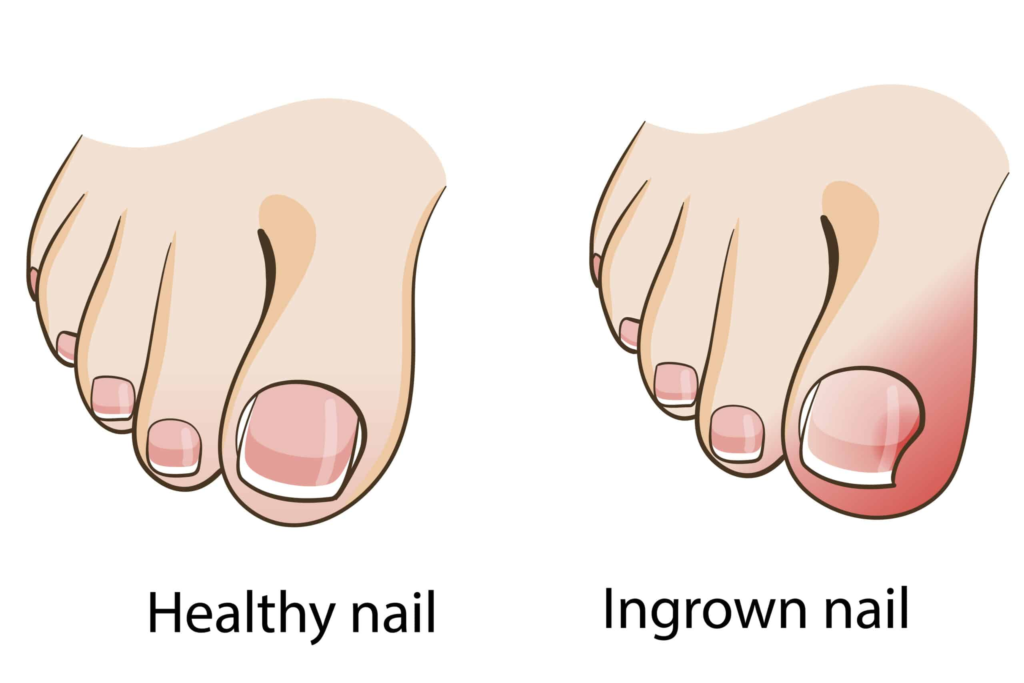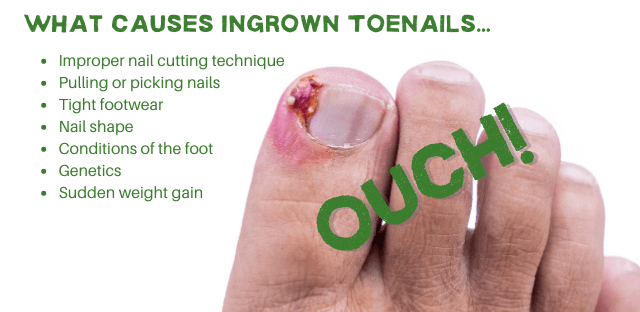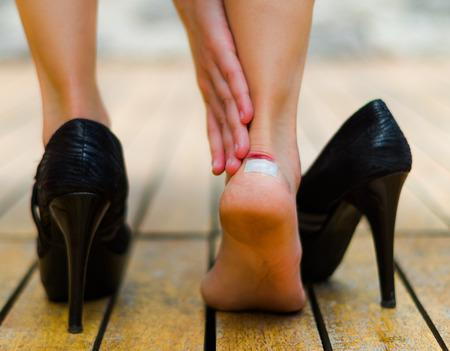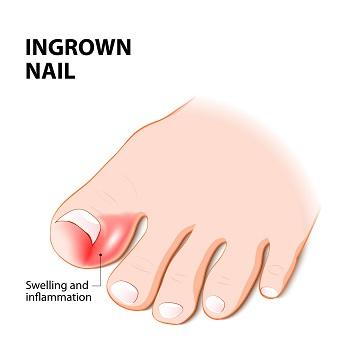Unlock the secrets to preventing and treating ingrown toenails with our expert guide. Discover pain relief methods, effective home remedies, and tips for maintaining optimal foot health. Step into comfort today!

Introduction
Ingrown toenails, a common yet often painful foot condition, can significantly impact your daily life. Understanding the root causes, symptoms, and effective remedies is essential for anyone looking to prevent or manage this condition. Our comprehensive guide delves into the intricacies of ingrown toenails, offering you the knowledge and tools needed for pain-free feet.
Table of Contents
Understanding the Root Causes of Ingrown Toenails

Ingrown toenails, a prevalent and often uncomfortable issue, stem from various sources. Identifying these factors is crucial for the effective prevention and management of ingrown toenails.
Mistakes in Nail Trimming
Incorrect Trimming: Trimming toenails too short or rounding the edges too much can cause the nail to grow into the surrounding skin. Employing proper nail-trimming techniques is vital for keeping toenails healthy.
Trauma: Injuries to the toenail, such as accidentally kicking something or having an object fall on your toe, can result in ingrown toenails. Taking precautions to avoid toe injuries can aid in preventing this condition.


Inappropriate Footwear
Tight Footwear: Shoes that don’t fit properly or are too tight can force the toenails into the skin, causing ingrown toenails. It’s important to choose shoes that fit correctly and provide ample room for your toes.
High Heels: High heels can distribute your body weight onto your toes, heightening the risk of developing ingrown toenails. Limiting the use of high heels and ensuring they fit well can help reduce this risk.
Genetic Predisposition
Individuals may be inherently more susceptible to ingrown toenails due to their genetic background, influencing the shape and growth direction of their toenails. Being aware of your genetic risk can assist in more effectively managing and preventing ingrown toenails.
By recognizing and tackling these key contributors, you can decrease the chances and discomfort of ingrown toenails, promoting healthier and more comfortable feet.
Recognizing Symptoms of Ingrown Toenails for Early Intervention
Early detection of ingrown toenails is key to initiating prompt treatment and finding relief. While symptoms can vary in intensity, there are several primary signs to watch for:
Pain and Tenderness
Pain: The most noticeable symptom of an ingrown toenail is pain along the side of the toenail, which can range from a mild discomfort to intense pain, depending on how far the nail has grown into the skin.
Tenderness: The area next to the ingrown toenail often becomes extremely tender, with even slight touches or pressure causing significant discomfort, indicating the area’s increased sensitivity.
Redness and Swelling
Redness: An evident sign of an ingrown toenail is the reddening of the skin around the nail, a sign of inflammation. This redness is a clear indicator of irritation caused by the ingrown nail.
Swelling: Along with redness, swelling is typically observed, with the affected area appearing larger due to fluid accumulation and increased blood flow, which are part of the body’s response to the ingrown nail.
Warmth: The area around the ingrown toenail may also feel warm to the touch, a symptom of the ongoing inflammation and increased circulation to the area.
Difficulty with Mobility
Walking Pain: The pain and pressure from an ingrown toenail can significantly hinder walking or standing, impacting daily activities.
Shoe Discomfort: Wearing shoes becomes a challenge, as the pressure on the inflamed area can worsen the pain, making it hard to keep shoes on for long periods.
Signs of Infection
Pus Formation: A more serious symptom of ingrown toenails is the appearance of pus near the affected area, which indicates a potential infection. This situation necessitates immediate medical attention to avoid further health issues.
Identifying these symptoms promptly and taking the necessary steps is crucial for effective ingrown toenail management. Early treatment can prevent complications, ensuring a quicker return to comfort and normal activities. Should symptoms continue or escalate, it’s important to consult a healthcare professional for appropriate diagnosis and treatment.
Managing Ingrown Toenails: Effective Home Remedies
Addressing ingrown toenails requires approaches that vary based on the severity of the condition. Here are some proven remedies to ease discomfort and promote healing:

Soaking in Warm Water
Advantages: Soaking the affected foot in warm water helps soften the skin around the toenail and reduces swelling, providing comfort from the pain.
Additives for Enhanced Effectiveness:
- Epsom Salt: Adding Epsom salt to the water can decrease inflammation and support the healing process.
- Antiseptic Additives: Including a gentle antiseptic in the soak can help prevent infection, a critical aspect of managing ingrown toenails.
Lifting the Nail Edge
Method: Carefully lifting the ingrown nail’s edge away from the skin can offer immediate relief by reducing the nail’s pressure on the skin.
Using Cotton or Dental Floss
Objective: Inserting a small piece of cotton or dental floss under the nail’s edge can help direct the nail’s growth away from the skin, alleviating pressure and preventing further ingrowth.
Applying Antibiotic Cream
Preventing Infection: The use of antibiotic cream is crucial for keeping the area clean and infection-free, fostering a conducive healing environment
Alleviating Pain
Options for Pain Relief: Taking over-the-counter pain relievers such as ibuprofen or acetaminophen can effectively reduce pain and inflammation. It’s important to follow the recommended dosages.
When attempting home treatments, it’s important to keep the area clean and handle it with care to avoid worsening the condition. If the ingrown toenail does not show signs of improvement, develops signs of infection, or if the pain becomes severe, seeking medical advice is crucial. Healthcare professionals can offer more advanced treatments or surgical interventions to solve the issue and help prevent its recurrence.
Preventing Ingrown Toenails and Promoting Foot Health
Preventing ingrown toenails and maintaining healthy feet is achievable with the right care and precautions. Here are essential tips to help prevent this uncomfortable condition and keep your feet in excellent health.
Proper Toenail Trimming Techniques
Straight Across Cuts: Always trim your toenails straight across to prevent the sides from growing into the skin. Avoid rounding the corners, which can encourage ingrown toenails.

Maintain Ideal Length: Ensure your toenails are not too short or too long. Extremely short nails may push into the skin when wearing shoes, and longer nails are more susceptible to injury. Aim for a moderate length that protects the nail and skin.
Selecting Suitable Footwear
Ensure a Good Fit: Choose shoes that provide ample space for your toes to move without restriction. Tight or narrow shoes can compress the toenails and lead to ingrown nails. Opt for footwear that complements the natural shape of your feet.

Orthotic Support: Individuals with specific foot conditions may benefit from orthotic inserts or insoles, which offer additional support and cushioning, minimizing the risk of ingrown toenails.
Foot Hygiene and Care
Keep Feet Clean and Dry: Wash your feet regularly with soap and warm water, and dry them thoroughly to prevent the skin around your nails from softening, a condition that can foster ingrown toenails.

Apply Foot Powder: For those prone to sweaty feet, foot powder can be a lifesaver. It absorbs excess moisture, keeping your feet dry and less susceptible to nail ingrowth.
Protecting Your Toes from Injury
Be Cautious During Activities: Take care to protect your toes during physical activities or work that poses a risk of toe injury. Proper footwear designed for specific activities can prevent accidents that may cause ingrown toenails.
Wear Protective Footwear: In situations where there’s a higher risk of dropping something on your feet or stubbing your toes, wearing protective shoes can shield your toes from injury and potential ingrown toenails.
By integrating these preventive measures into your daily routine, you can significantly reduce the risk of ingrown toenails and ensure your feet remain healthy and comfortable. Foot care is an important part of overall well-being, and these strategies are key to keeping your feet in prime condition.
FAQ Section
Q: What are the main causes of ingrown toenails?
A: Ingrown toenails can result from improper nail trimming, wearing tight footwear, genetic predisposition, and toe injuries.
Q: How can I recognize an ingrown toenail?
A: Look for symptoms like pain and tenderness along the nail edge, redness, swelling, and in severe cases, signs of infection such as pus formation.
Q: What are some effective home remedies for ingrown toenails?
A: Warm water soaks with Epsom salt, gently lifting the nail edge, using cotton or dental floss to guide nail growth, applying antibiotic cream, and taking pain relievers can all help alleviate symptoms.
Q: How can I prevent ingrown toenails?
A: Preventive measures include proper toenail trimming, choosing well-fitting shoes, maintaining foot hygiene, and protecting your toes from injury.
Conclusion
Ingrown toenails don’t have to be a recurring pain. With the right preventive measures and timely remedies, you can maintain healthy, comfortable feet. Remember, early detection and treatment are key to avoiding complications. Should you experience persistent pain or signs of infection, seeking professional medical advice is crucial. Embrace these strategies to keep your steps light and pain-free, ensuring your feet remain in top condition.
| Arch Support |
| Arch Supports |
| Best Arch Support Insoles |
| Best Insole for Plantar Fasciitis |
| Insole for Flat Feet |



MOST COMMENTED
Animal-Based Proteins / Casein Protein / Dietary Protein / High-Protein Diets / Pea Protein / Plant-Based Proteins / Protein / Protein Deficiency / Protein Supplements / Proteins / Whey Protein / Whey Proteins
Is Protein Powder Safe for Teenagers and Children?
Animal-Based Proteins / Casein Protein / Dietary Protein / High-Protein Diets / Pea Protein / Plant-Based Proteins / Protein / Protein Deficiency / Protein Supplements / Proteins / Whey Protein / Whey Proteins
Unlock the Power of Proteins for Optimal Gut Health
Multivitamin
Total Health: Multivitamin for Active Lifestyles
Multivitamin
WellnessFusion: Complete Multivitamin Support
Dietary Supplement
Revitalize Your Health: The Magic of Red Yeast Rice Capsules
Foot care / Foot Health
Revitalize Your Foot Care Routine: Essential Tips for Optimal Foot Health
Foot Problem / Diabetics / Foot Health
Diabetics: Mastering Footwear Selection for Enhanced Foot Health and Ultimate Comfort
Exercises and Footwear Tips for Hammertoe Relief / Foot care / Foot Health / Foot Pain / Foot Problem / Hammertoes
Unlock Effective Exercises and Footwear Tips for Hammertoe Relief
Hammertoes / Foot Health / Foot Pain / Foot Problem
Unlock Relief: Essential Guide to Hammertoes Causes, Symptoms, and Treatments
Foot Problem / Foot Health
Revolutionize Your Recovery: Natural Remedies for Plantar Fasciitis – Fresh Home Keepers